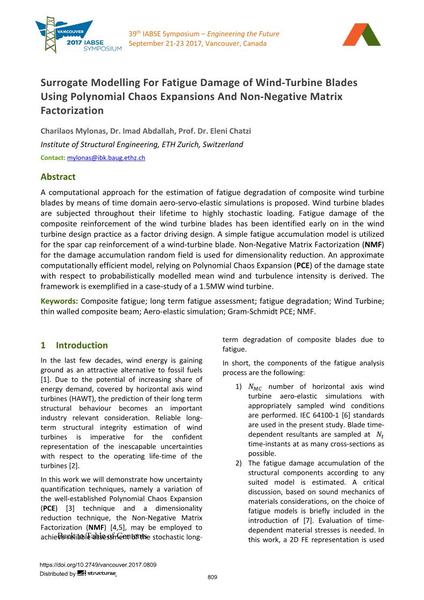Surrogate Modelling For Fatigue Damage of Wind-Turbine Blades Using Polynomial Chaos Expansions And Non-Negative Matrix Factorization

|
|
|||||||||||
Bibliographic Details
| Author(s): |
Charilaos Mylonas
(Abstract)
Imad Abdallah Eleni Chatzi |
||||
|---|---|---|---|---|---|
| Medium: | conference paper | ||||
| Language(s): | English | ||||
| Conference: | IABSE Symposium: Engineering the Future, Vancouver, Canada, 21-23 September 2017 | ||||
| Published in: | IABSE Symposium Vancouver 2017 | ||||
|
|||||
| Page(s): | 809-816 | ||||
| Total no. of pages: | 8 | ||||
| Year: | 2017 | ||||
| DOI: | 10.2749/vancouver.2017.0809 | ||||
| Abstract: |
A computational approach for the estimation of fatigue degradation of composite wind turbine blades by means of time domain aero-servo-elastic simulations is proposed. Wind turbine blades are subjected throughout their lifetime to highly stochastic loading. Fatigue damage of the composite reinforcement of the wind turbine blades has been identified early on in the wind turbine design practice as a factor driving design. A simple fatigue accumulation model is utilized for the spar cap reinforcement of a wind-turbine blade. Non-Negative Matrix Factorization (NMF) for the damage accumulation random field is used for dimensionality reduction. An approximate computationally efficient model, relying on Polynomial Chaos Expansion (PCE) of the damage state with respect to probabilistically modelled mean wind and turbulence intensity is derived. The framework is exemplified in a case-study of a 1.5MW wind turbine. |
||||
| Keywords: |
wind turbine Composite fatigue long term fatigue assessment fatigue degradation thin walled composite beam aero-elastic simulation Gram-Schmidt PCE NMF
|
||||
